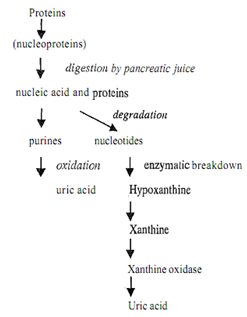Q. Define the Role of Protein and Purines?
Cellular materials of plants, grams and legumes and animal glandular organ meats (liver, pancreas brain, kidneys) contain nucleoproteins. The nucleoproteins are digested and converted to purines, which are finally oxidized to uric acid. The steps involved in degradation of purine to uric acid are diagrammatically presented in Figure. Uric acid, therefore, is a substance that results from the breakdown of purines, which are part of all human tissue and are found in many foods. You may also recall studying that the body call also synthesize proteins from carbon and nitrogen compounds (acetic acid, glycine) from carbohydrates, protein or fat and give rise to uric acid.

It is important to understand that uric acid is normally excreted in the urine. However, excess of uric acid produced by the body from protein we eat and/or internal cellular or N, utilization can increase the uric acid levels of the blood. The range of uric acid is 2-7 mg/100 ml. If the level of uric acid in our body is above 7 mg/100 ml, we have a risk of developing the disorder called gout. In severe gout, the levels of uric acid may go up to 20 mg/100 ml.
Normally, uric acid is dissolved in the blood and passed through the kidneys into the urine, where it is eliminated, IS the body increases its production of uric acid or if the kidneys do not eliminate enough uric acid from the body, levels of it build up in the blood resulting in a condition called hyperuricemia. I-Iyperuricemia also may result when a person eats too many high-purine foods, such as liver, dried beans and peas and gravies. Iiyperuricemia is not a disease and by itself is not dangerous. However, if excess uric acid crystals form because of hyperuricernia, gout can develop. The excess crystals build up in the joint-spakes, causing inflammation. Deposits of uric acid can appear as lumps under the skin around the joints and at the rim of the ear. In addition, uric acid crystals can collect in the kidneys and cause kidney stones.